How have the price components in nursing homes - care rates, remuneration for accommodation and meals and investment costs – developed in recent years?

Is care becoming more and more expensive?: Nursing home costs and own shares
IW-Report

How have the price components in nursing homes - care rates, remuneration for accommodation and meals and investment costs – developed in recent years?
Is it true that long-term care has become increasingly expensive? A closer look shows a very differentiated picture: The impression made in the public that nursing costs in long-term care are continuously increasing, can only be partially confirmed: By 2015, the prices of care services have increased significantly in some regions, also in comparison to the general consumer prices, while in other states (Bundesländer) they lagged behind this trend. The same applies to the fees charged for accommodation and meals and the investment costs that can be charged to the person in need of care.
Far more significant for price perception, however, is the proportion of care costs that are not covered by the statutory long-term care insurance and are billed to those in need of care. It has increased significantly in the past - across all states. The reason for this is that until 2015, the insurance lines were not adjusted to the actual cost development in this economic sector. The significant part of this feeling, if not the most significant ones, is the fact that, by 2015, insurance benefits were actually devalued over time.
Since the latest reform in 2017, a significant increase in this self-supporting share of the nursing costs can again be observed in all federal states - but here again in a large variance between just under 9 percent (Berlin) and almost 66 percent (Thuringia). The reasons for this recent increase can not yet be precisely investigated due to the lack of publicly available data on the nursing rates. Therefore, only a few hypotheses are formulated here, which should be examined in more detail in the future.

Susanna Kochskämper: Wird Pflege immer teurer? Pflegeheimskosten und Eigenanteile
IW-Report

More on the topic

The Political Economy of Pension Reform
As the German population ages, the country’s statutory pension scheme, which is financed on a pay-as-you-go basis, requires higher and higher contributions while the level of pensions is falling.
IW
Expenditures and Revenues in Germany’s Statutory Health Insurance
Almost annually recurring deficits in Germany’s statutory health insurance system have led to a steady rise in the contribution rate, a percentage of earned income.
IW